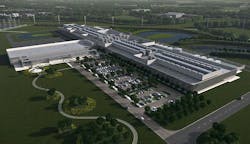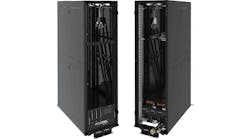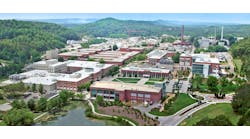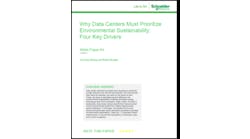In the western suburbs of Dublin, as you cross the M50 highway that rings the city, the housing developments thin out and yield way to large industrial estates. This is where the cloud meets the earth.
This area of Ireland is one of the best places in the world to use fresh air to cool servers. That’s why it is home to a cluster of huge data centers that bring cloud services to European users, including server farms for Microsoft, Amazon Web Services and Google.
And now Facebook as well. On Sunday CEO Mark Zuckerberg confirmed that Facebook will build a huge new data center in Clonee in County Meath. Describing the company’s data centers as “some of the most complex machines ever created,” Zuckerberg said the new facility would be fully powered by renewable energy.
Ireland’s supply of renewable energy has also attracted Apple, which opted to bypass the Dublin cluster and build a massive data center near Galway on Ireland’s west coast. Ireland has 229 wind farms spread across its 26 counties, with total generation capacity of more than 3,000 megawatts of electricity.
“Ireland’s ability to generate and distribute energy from the wind banks to the data centres clustered around Dublin is cited as one of the attractive points when hosting from Ireland, for sure,” said Garry Connolly, President of Host in Ireland, an industry group seeking to boost data center development. “In the case of Apple, they have built in Galway, which is closer to the wind farms themselves.”
A Growing On-Ramp to the Cloud
The combination of energy efficiency and renewables, along with a favorable tax environment and skilled IT workforce, has established Ireland as Europe’s leading hub for cloud data centers. Connolly sees further growth ahead for Ireland’s data center industry, as the existing cloud ecosystem serves as a magnet for companies seeking to house data near the on-ramps to the public clouds.
“Dublin now has the hyperscale list complete with Facebook, Google, Amazon and Microsoft all now on the T50 (our fibre ring around Dublin),” said Connolly. “The opportunities for the colo has never looked as bright. The evolving hybrid cloud enables the colo providers to connect directly on the Dublin Ring to any one of the hyperscale platforms without having any detrimental performance issues or subsea cable risks. And as all the data remains in Ireland for the hybrid model, data sovereignty also is clearer.”
Several of the emergency backup generators outside one of Digital Realty’s data centers in the Dublin region. (Photo: Digital Realty)
Data sovereignty is actually a complicated story in Europe, and is shaping up as a driver for data center growth in markets like Germany that are cracking down on the movement of consumer data beyond borders. There’s also the overhang of a pending data privacy case in which the U.S. is suing Microsoft, seeking to access data stored in its Dublin facility.
But Ireland’s cloud community has built powerful momentum, and appears positioned to experience benefits similar to cloud clusters in major U.S. markets like northern Virginia, where each new data center reinforces its business value.
Dublin and Chill
News accounts about the new Facebook data center in County Meath describe Clonee as a village, and indeed it has a population of just 630, with plenty of open land (the name Clonee means “Aodh’s pasture”).
But it’s actually not nearly as remote as some of Facebook’s other data centers in Oregon or North Carolina. Clonee is about 10 miles from the heart of Dublin, and to get there you’ll drive right past major data centers for Amazon, Digital Realty, Equinix/Telecity, Dataplex and Digiweb in industrial estates in Blanchardstown and Ballycoolin.
There’s another major cluster about 10 miles south in Clondalkin, home to server farms for Google, Microsoft, Equinix/Telecity and Digital Realty. Amazon Web Services, Eircom and Citidel100 also have data facilities spread around the Dublin fiber ring.
One of the key assets of Dublin is its climate, which is ideal for data center cooling, allowing companies to bring fresh air into the data hall instead of using power-hungry chillers to refrigerate cooling water. The average annual temperature ranges between 23 and 80 degrees F (-5 to 27 degrees C), allowing most data centers to use free cooling year-round under normal operating conditions.
This approach to free cooling, known as air economization, can dramatically reduce the amount of energy used in cooling. The Google and Microsoft data centers near Dublin each operate with Power Usage Effectiveness (PUE) ratings between 1.1 and 1.2, making them among the most efficient data centers in the world.
The view of County Meath, Ireland from the Stone of Destiny atop the Hill of Tara, where tradition says the high kings of Ireland were once crowned. Yes, it can be rainy in Ireland. (Photo: Colleen Miller)
Zuckerberg noted the importance of fresh air cooling in his announcement of the Clonee data center. “One interesting engineering detail is that we’re cooling the facility with outdoor air, but because this is near the Irish Sea we’ll be using an indirect air cooling process to filter the salt from the air,” he said.
Zuckerberg didn’t add details of Facebook’s implementation of indirect air cooling, which doesn’t introduce fresh air directly into the data hall. But hey, you have to like a CEO that can talk about free cooling.
The Road Ahead
The big picture for cloud hosting in Europe was somewhat muddied by last year’s “Safe Harbor” controversy, in which a European court struck down rules for data transfer between the U.S. and Europe.
Meanwhile, a ruling is anticipated soon in a court case in which the U.S. Department of Justice is seeking access to data stored at Microsoft servers in Dublin. The case is primarily about the reach of U.S. law enforcement, rather than Ireland’s status as a data center destination. But the case is being closely watched as a bellwether for data sovereignty.
Neither development deterred Facebook from its decision to build in Ireland. Meanwhile, Host in Ireland sees continued growth for the sector based solely on demand within its borders, noting that more than 900 U.S. companies have operations in Ireland, and just 25 percent of them host IT operations here.
“The expansion opportunities are great,” said Connolly. “I have always just seen the development of the data centres and hosting in Ireland as a natural evolution of our digital offering, which started 60 years ago with IBM and Punch cards.”
That history is part of Host in Ireland’s “five Ps” – power, pipes, people, policy and pedigree. Connolly says the slogan speaks to the range of factors involved in data center site selection.
“It is not just a IT or facilities decision anymore,” said Connolly. “The sovereignty of data, the distributed profits and the IP protection all have a role to play along with Ireland’s commitment to being a pro-business environment. We anticipate the cloud will continue to grow from Dublin.”






